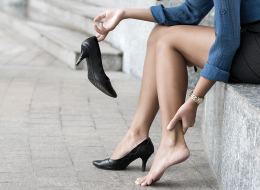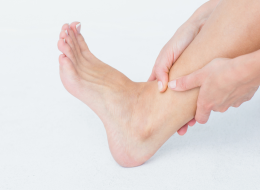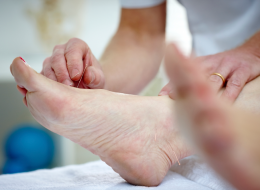Bottoms Up What’s Causing My Foot Arch Pain?
Find out what’s likely causing your foot arch pain and burning, and learn treatment options that help relieve the symptoms hurting the bottom of your feet.
Do you often feel an intense, shooting pain on the bottom of your foot between the toes and heel? Or a burning sensation in that same middle section of your soles? If so, you are experiencing foot arch pain (sometimes called arch strain), and there are a variety of conditions that cause the discomfort.
Causes of Arch Pain: Types And Diagnosis
The curved, contoured area on the bottom of your feet, located between the ball of the foot and your heel, is called the arch of the foot. It consists primarily of fibrous tissues called ligaments that hold your foot bones together and connect the toes to the heel. Foot muscles and a tough tissue known as the plantar fascia are also located in the arch of the foot and assist in providing support to the foot.
Some people have high arches, while others have low arches — and both affect the way your feet and legs work when you’re walking and running. But it’s not just the shape of your arch that can affect regular body mechanics and cause pain. Check out the list of common arch pain causes below to help identify what’s leading to your foot pain:
Plantar Fasciitis
If you often feel a sharp, stabbing pain on the underside of your foot toward the heel, then you may have a very common condition called plantar fasciitis. The injury (sometimes called jogger’s heel) is characterized by pain and inflammation of the plantar fascia, which is the thick band of tissue that runs across the bottom of the foot and connects the heel bone to the toes. Plantar fasciitis pain is usually worse in the morning and tends to decrease throughout the day. However, it can be triggered by long periods of standing or excess walking.
MORE FROM FOOTFILES:
Most cases of plantar fasciitis are caused by extreme stress on the foot muscles. This can come from things like wearing high heeled or uncomfortable shoes, being significantly overweight, exercising too much or engaging in exercise your body isn’t ready for, and certain foot abnormalities (like flat feet or high arch foot).
To read more about plantar fasciitis and how to treat the condition, click here.
Plantar Fascia Tear
A tear in the plantar fascia can also cause intense arch pain that becomes worse during physical activity. Most people with a torn plantar fascia experience most of their pain in the heel, but arch pain is also common. If a doctor determines you have torn or sprained your plantar fascia, you may have to have surgery and/or wear an immobilization boot or cast. Physical therapy and immobilization are typical after or in place of orthopedics.
Flat Feet
Nearly one third of people in the United States are born with a foot deformity called flat foot (a.k.a. fallen arches). The condition is characterized by a very low or non-existent arch in the foot that results in most (and sometimes all) of the sole of the foot to touch the ground. People who are not born with the condition can also develop it over time if the tendons that make up the arch of the foot are injured or stretched and no longer pull together properly.
Usually having flat feet is painless, but some people experience pain in the heel and arch area of the feet while running, walking and jumping. Specially made orthotics can usually reduce any arch pain associated with the condition.
To read more about the symptoms and treatment of flat feet, click here.
High Arch Foot
A condition called high arch foot, or supinated foot, is another common foot deformity that can cause arch pain. The condition is characterized by the sole of the foot being unable to flatten while bearing weight, which can create pain in the arch of the foot as well as in the ankles, calves, knees and back.
Most cases of high arch foot are present at birth, but it can be triggered by things like stroke, rheumatoid arthritis, diabetes, cerebral palsy, Charcot-Marie-Tooth disease and other medical conditions.
In addition to arch pain, high arch foot often causes hammertoes, calluses, Achilles tendonitis and metatarsalgia.
To read more about high arch foot causes and treatment, click here.
Tarsal Tunnel Syndrome
Tarsal tunnel syndrome is foot condition characterized by compression of the tibial nerve that runs through the tarsal tunnel found along the inside of the ankle. Though tarsal tunnel syndrome usually causes pain and tingling in the heels, ankles and lower legs, it sometimes creates a tingly, burning sensation in the arches of the feet that radiates up to the knees.
To read more about tarsal tunnel syndrome symptoms and treatment, click here.
Foot Injury (Sprain, Bone Fracture or Bruise)
Sometimes foot injuries like sprains, bone fractures and bruises can lead to arch pain. An example would be stepping on something that damages the structure of the bottom of your foot or twisting the arch of your foot in an unnatural position during exercise or athletic activities. If you’ve recently experienced a foot injury and have arch pain, you should visit your doctor or podiatrist to rule out a foot sprain, bruise or bone fracture.
Neuromas
A neuroma is a swelling of the nerve that is typically caused by an injury, overuse of the feet or trauma. Sometimes called nerve tumors, the most common place for neuromas is in the ball of the foot. Symptoms associated with neuromas include burning pain and numbness in the toes, but in rare cases, patients can experience arch pain, as well. Common treatment for neuromas includes cortisone injections, orthotics and surgery.
Arthritis
Arthritis is a disease that causes pain, swelling and inflammation of the joints. When arthritis affects a person’s feet, he or she often makes adjustments in walking style in order to avoid pain. This can put undue stress and pressure on different parts of the feet, which can then lead to arch pain.
YOU MAY ALSO LIKE:
Overuse
Sometimes arch pain is simply due to overuse of the foot, whether that be walking long distances, engaging in repetitive motion of the feet for an excessive amount of time, or exercising beyond one’s current abilities. Overuse can cause muscle and tendon fatigue as well as injuries like hairline fractures, all of which can lead to arch pain.
Callus, Bunion or Hammertoes
Though it’s rare, certain foot conditions like bunions, hammertoes and calluses can cause pain in the arch of your foot. Each of these ailments is able to disrupt your normal gait and can also create pressure that irritates the arch and other areas of the foot. Calluses can be easily removed with just a few simple home remedies, while bunions and hammertoes may require orthotics to help ease the pain. All three conditions create less pain when a person wears properly fitted, comfortable shoes with no heels or very low heels.
When To Seek Treatment For Arch Pain
If your arch pain begins to interfere with your daily routine and activities, you should consider seeking medical attention. You should also visit a doctor for arch pain if the arch of your foot looks discolored or deformed (both of which are symptoms of an injury or bone fracture), is extremely sensitive to touch or is causing you to move and walk differently.
If none of the above conditions seem like the source of your foot pain, you may want to check to see if you have a very common foot condition called achilles tendonitis. You could also try some these foot massage techniques to help relieve arch pain.
Notice concerning medical entries:
Articles having medical content shall serve exclusively for the purpose of general information. Such articles are not suitable for any (self-) diagnosis and treatment of individual illnesses and medical indications. In particular, they cannot substitute for the examination, advice, or treatment by a licensed physician or pharmacist. No replies to any individual questions shall be effected through the articles.








